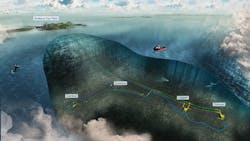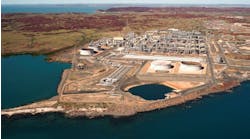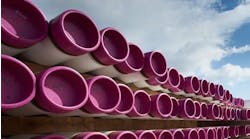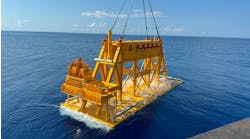Jeremy Beckman
Editor, Europe
Production of gas-condensate from theLaggan and Tormore fields has performed largely as expected since start-up in late January. As with any deepwater subsea tieback involving transportation of liquids-rich gas, the facilities must be protected against hydrate formation and wax build-up. This project presented special challenges as the UK’s longest and deepest-water tieback to date - over 600 m (1,968 ft) - and in the harsh environment west of Shetland.
Total operates the two fields in partnership with DONG Energy and SSE. The fields, containing an estimated 1 tcf of gas, plus 33 MMbbl of condensate, are currently producing over 90,000 boe/d from five wells, four on Laggan and one on Tormore, each equipped with a subsea multiphase flowmeter. A six-slot, 900-metric ton (992-ton) manifold/template on each field is connected to two 143-km (89-mi), 18-in., multiphase pipelines that transport the wellstream to the new Shetland Gas Plant (SGP) at Sullom Voe. From the SGP, monoethylene glycol (MEG) is supplied to the wells through a 143-km, 8-in. carbon steel line, with control and power for the subsea production system provided by an umbilical. Following processing at SGP, the gas heads through the SIRGE export pipeline through the North Sea to eastern Scotland.
According to David Hainsworth, Operations Manager for Total E&P UK, the gas-condensate ratios for the two fields are different, with Tormore’s condensates being a little more waxy. There are also differences in water chemistry between the fields, so Total tailored the MEG injection system to accommodate a range of fluid compositions for these and other satellite fields in the area.
Among this group, also operated by Total, are the 140-bcf Edradour, due to come onstream late next year via a single subsea well, a 16-km (9.9-mi) export pipeline and a 6-km (3.7-mi), 2-in. MEG service line connected to theLaggan-Tormore infrastructure; and the 38-bcf Glenlivet, a two-well tieback to be connected via a 35-km (21.7-mi) export pipeline, an 18-km (11.2-mi), 6-in. line importing MEG from the Edradour manifold, and a 19.2-km (12-mi) umbilical from Edradour. Glenlivet could start production next summer.
Seawater temperatures along the route of the pipelines can dip to -1°C (30°F), cold enough for the wellstream to crystallize into hydrates, leading to subsequent blockages. MEG is therefore injected continuously into the subsea wellheads at a rate of 17 cu m/hr (600 cf/hr), with the returning MEG separated from the incoming hydrocarbons at the SGP. Waste heat recovered from the gas turbine power generation systems and compressors at the site is used to drive the process.
“The rate of MEG injection is fairly constant,” Hainsworth said. “What we’re doing is optimizing what we’re injecting. At the Shetland Gas Plant, there is also some water in the wellstream that needs to be stripped out, although not so far formation water due to reservoir breakthrough. However, the system is also designed to deal with this eventuality and any associated salinity.”
Cameron designed the MEG treatment/regeneration equipment, which is an adaptation of the company’s proprietary technology. Total engineers monitor the system: at present, a Cameron technician is on hand at the site under a maintenance agreement, but as Total’s team becomes more familiar with how the system works, this will switch to a service agreement.
“By having MEG in the pipeline system we are protected permanently against hydrates,” Hainsworth said. “We also perform pigging runs every three months through the export lines to check for any wax build-up. So far we’ve encountered very little wax, but we do have a mechanism for injecting wax inhibitor if needed. When we pig the lines, following a temporary production shutdown, all the liquids are emptied back to the SGP and any incoming liquid MEG slugs are sent to storage tanks. Regenerating MEG after a pigging run typically involves a 10-day turnaround.”
In addition to MEG, Total investigated alternative injection methods using methanol, or kinetic hydrate inhibitors with another chemical. Trace heating for the pipelines was discounted as not being a fully proven technology, with only limited deployments. “We performed a screening study and decided that MEG gave us the optimal flexibility going forward,” Hainsworth said. “We have a hub and the infrastructure, and this technique gave us the flexibility we need for future tie-ins.”
For the virtual flow assurance modeling, Total used Schlumberger’s established dynamic multiphase flow simulation tool OLGA. For the pipeline management system, however, the company developed a multiphase model to optimize its pigging requirements using LedaFlow, the first time the software has been integrated into a PMS anywhere, Hainsworth claimed. LedaFlow, developed by SINTEF, Kongsberg, Total, and ConocoPhillips over the past 15 years, is a transient multiphase flow simulator designed for various types of flow assurance studies, including slug-capture prediction. It is said to provide more refined mathematical representations, leading to improved understanding of the multiphase flows.
Laggan-Tormore is important to Total as the company’s first deepwater long gas tieback, but the company has other opportunities around the world where hydrate inhibition will be needed, Hainsworth noted.




